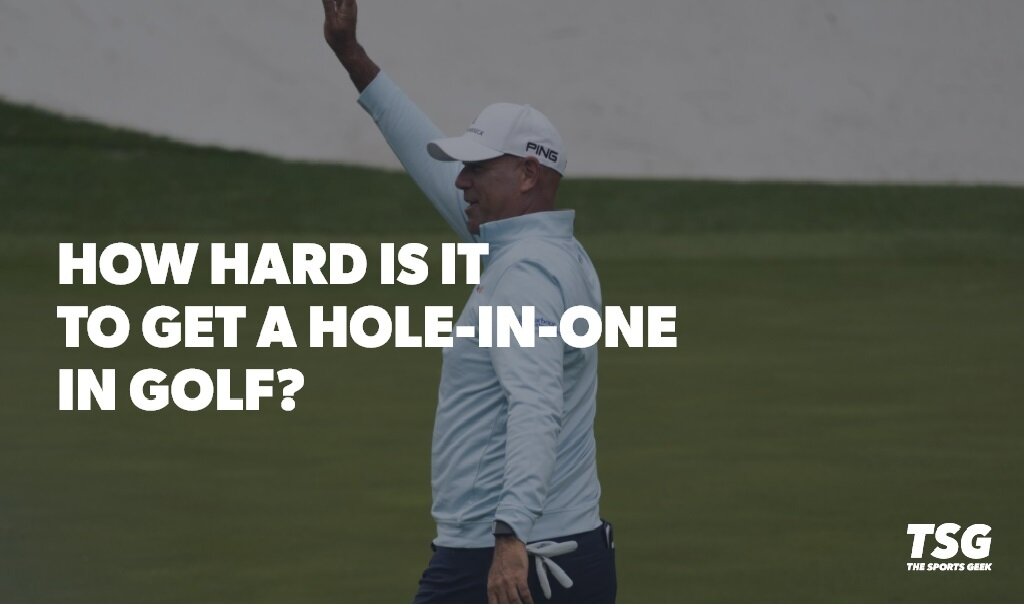
If you’re wondering how hard it is to get a hole-in-one, I’ll make it simple: it’s VERY hard. It’s extremely difficult for the pros, and for us weekend golfers, it’s almost impossible, unless you get really lucky!
I’ll break down the odds of a hole-in-one for the pros and the amateurs, and give you some tips on how to at least give yourself a shot. I’ll also go through the history of hole-in-ones at the majors, and where you can wager on it!
How Hard Is It to Get a Hole-In-One?
According to the U.S. Hole In One Association, the odds of a professional golfer scoring a hole-in-one on a par-3 hole are approximately 2,500 to 1. That makes them five times more likely to record an ace than the average amateur.
Their chances of knocking their tee shot in the hole on a par-3 are around 12,500 to 1, but that’s a very rough average and your personal chance can vaery greatly.
The odds of recording an ace in your lifetime obviously depends on a variety of factors:
- How good you are
- How often you play
- The variables of any day you golf (for example, weather)
If you are a low-handicap player (generally shooting in the 70s or low 80s), and were to play 25 rounds per year for 40 years, you’ve got about a 20% chance to get at least one hole-in-one.
If you’re generally happy to break 100, and you averaged around 12 rounds per season for 40 years, your chances of ever scoring an ace would be around 5%.
No wonder that hole-in-ones are such a celebrated achievement. According to tradition, anyone who hits an ace is required to buy drinks following the round for any players who were in their group, and even the entire clubhouse. However, it might be worth it to get that elusive hole-in-one!
How to Get a Hole-In-One?
To suggest that a lot of different things need to go right for you to get a hole-in-one is an understatement, but that’s what makes it such a rare feat.
The first thing required for a hole-in-one to take place is that the hole needs to be reachable within one shot. That eliminates par-4s and par-5s from the equation (only one PGA Tour player has ever recorded an ace on a par-4, Andrew Magee in 2001), which limits golfers’ chances of scoring an ace to just 4-5 holes in a given round, depending on the course.
The next critical component of a hole-in-one is accuracy. Obviously, you don’t have a chance at knocking the ball in the hole if you slice your drive 50 yards right of the green. The ball won’t roll into the cup if you sail over the green into a bunker, or splash the ball into the water in front of the green.
The ability to hit the ball high in the air is also an advantage. If you drill a line drive at the pin, the ball is more likely to either bounce off the flag stick, or lip out of the cup. But if you can land the ball softly and allow it to roll slowly towards the hole, your chances of the ball landing in the cup are much higher.
But while accuracy and a soft touch will improve your chances of scoring an ace, luck is going to play a much more significant role in determining if, and when, you get a hole-in-one. Even if you estimate the impact that the wind is going to have on your ball, you’re at the mercy of a stiff gust of wind. You also never know exactly how the ball is going to bounce when it lands on the green.
How Often Do Hole-In-Ones Happen in Majors?
If the final round of the 2016 Masters was your first time ever watching a golf major championship, you wouldn’t have thought that a hole-in-one is really that big of a deal. Three players that day (Shane Lowry, Davis Love III, and Louis Oosthuizen) needed just one shot to complete the 16th hole that Sunday.
Truth be told, aces at the Masters (or any other major for that matter) are much rarer than that. Even after the trifecta of hole-in-ones at the 2016 Masters, and an ace the following year by Matt Kuchar, Augusta National has yielded just 34 hole-in-ones to the pros since the tournament began in 1934.
24 of the 34 aces have happened at the legendary 16th hole. The most recent was Stewart Cink in 2022.
The US Open has also featured just 53 aces in its history, which dates back all the way to 1895. Incredibly, nearly 10% of those hole-in-ones came within a two-hour time span in 1989, when Drew Weaver, Mark Wiebe, Jerry Pate, and Nick Price each used a 7-iron to ace the sixth hole at Oak Hill Country Club. Victor Perez joined the club in 2025, using a 7-iron to ace the 192-yard sixth hole at Oakmont.
Si Woo Kim’s hole-in-one at the 2025 PGA Championship was the tournament’s first ace since 2024, when Sebastian Soderberg aced the 190-yard par-3 eighth hole. Kim’s hole-in-one on the par-3 sixth hole was the longest in major history at 252 yards! It was the 51st hole-in-one at the PGA Championship.
Meanwhile, going into 2025, there have been 27 hole-in-ones since 1981 at the British Open championships. However, the last one to do it? Si Woo Kim in 2024.
That is the longest hole in one in Open Championship history. The 2025 Open Championship will be played at Royal Portrush in Northern Ireland. If there are any long par-3s, you might want to lay a small wager on Kim to pull it off!
Where to Bet on Hole-In-One Odds?
You can find hole-in-one odds at many golf betting sites ahead of the majors, and for select tournaments among the props. I prefer BetUS, which has featured Masters hole-in-one prop bets for the last few years.
In 2023, you could find hole-in-one odds at Augusta at -210! These odds are generally released closer to the tournament, usually the week of the event, so that’s the place to check if you want to bet on hole-in-ones.

Welcome Bonus
225% up to $3,625
- Three decades of experience
- Big welcome bonus worth up to $2,625
- Thousands of sports betting options



You must be logged in to comment. Don't have an account? Sign up today.